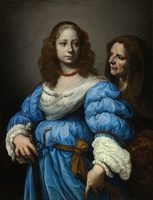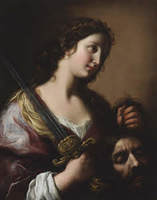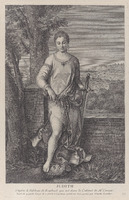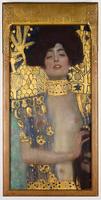Late 17th to Early 20th Century
A woman with red ringlets framing her face looks off to the side. The woman, Judith, wears an extravagant blue gown with puffy sleeves. She wears a string of red pearls around her neck, a red flower adorning the left side of her head. In her right hand, she is gripping a sword with an intricate silver handle. Her right hand reaches slightly behind her into the shadows where the severed head of a man is nearly disappearing into the shadows. To the left of her is her maidservant, adorned in a brown, hooded garment; she is looking at Judith with an almost concerned expression on her face as Judith ignores her, stoically looking off into the distance.
Felice Ficherelli was an Italian painter born 1603 in San Gimignano. His most original works were often of cruel and violent subjects, which he interpreted with a morbid sensuality and ambiguous tenderness. His compositions are known to be clear with luminous drapery, and he drew from the sfumato effects of Furini, developing a similar style to that of Cecco Bravo, his later works characterised by a new softness and freedom.
A woman with brown curly hair pulled away from her face looks contemplatively into the distance. She is wearing a purple gown with a white underdress and gold accents. In her left hand, she holds the severed head of the Assyrian general Holofernes by his black hair. In her right hand she holds the sword used to kill him held by its intricately detailed, gold handle.
Born Sigismondo di Pietro Marinari in 1627 Firenze, Italy, Onorio Marinari was the son of painter Gismondo Marinari from whom he received his first instruction. He became the pupil and assistant of the artist Carlo Dolci who was also his cousin. He executed a number of altarpieces for Florentine churches and his 1707 fresco in the Palazzo Capponi in Florence. After the death of Dolci in 1686, he undertook a large amount of his work for the Medici court.
Made after Giorgone's 1504 oil painting "Judith," a woman stands in front of a brick fence before a pastoral landscape. She is alone save for the severed head of a man she is holding down with her left foot. She is a fair maiden, with Mona Lisa-like features and fine hair pulled away from her face. She is wearing an Arthurian gown with a grand sword gripped in her right hand.
Antoinette Larcher was a French artist born in Paris, 1685. A native of France, her career in historical subject engraving flourished around 1725. Among these historical subject engravings was her eighteenth-century engraving Judith standing with her foot on the head of Holofernes.
Larcher's Judith engraving was one of many made after the well-studied image of Giorgone's sixteenth-century oil painting. Her rendition of the scene was considerably broader with a tree further to the right and a broad pastoral landscape to the left. Prior to her engraving, it was uncertain what Giorgone's painting was intended for, having been composed on a narrow, vertical canvas. From her engraving researchers were able to surmise that the painting likely served as a door, concluding that the painting did in fact serve as a door of a built-in closet.
A woman with ivory skin and black hair pulled up into a simple updo stares sensually at the viewer. Her cheeks are flushed, bare breasts exposed beneath the near transparent blue gown she is draped in. Much like the rest of the composition, the gown is accented with elaborate, gold embellishments. This woman is the Jewish heroine Judith and, save for her body, the rest of the composition is overwhelmed with these rich blues and golds—making it appear as though she is disappearing into it (something the artist, Klimt, was known to do). Although her left hand is obscured, we see that within it she is holding the severed head of the Assyrian general Holofernes. Her right hand supports the head and makes it look like she is trying to push the head (the testament of her crime) out of view. The painting is displayed in a wooden frame with gold embellishments at the apex and a risen inscription that reads “Judith and Holofernes.”
Born in Vienna, Austria in 1862, Gustav Klimt has taken the iconic subject of Judith and Holofernes and tranformed Judith into a Viennese society beauty. His model for Judith was Adele Bloch-Bauer, whom he had a close relationship with and used from many of his paintings. Evidently, there are two styles Klimt uses for his women: the first is that of a dark-haired woman with an angular build, and the other is a fleshy, Rubenesque woman as seen in his painting Danae. This is one of two of Klimt's Judith paintings, both of which follow his first style.
Klimt has depicted a sensual Judith with a nearly orgasmic expression as she holds up the head of Holofernes (something which shocked his Viennese audience). He has made Judith into a femme fatale, a woman clearly taking pleasure in her actions, after the Jewish widow who risked her virtue in order to save her city. Despite the title on the frame, many could not accept this as Judith, finding it much easier to refer to it after the murderess Salome (something that followed him in his second rendition of Judith as well.
Klimt gives us a Judith who, in a sense, has also been decapitated. The heavy gold choker she wears, fashionable in early twentieth-century Vienna, starkly separates her own head from her body.
Between a thick, gold, and vertical frame a woman with black hair is turned away from the viewer. The woman, Judith, has her bare breasts exposed, a blue gown falling off of her shoulders. In true Klimt fashion, the gown is made of a plethora of different colored shapes of pink, red, white, black, yellow. The background is painted a rich rust color with gold swirls to the right of Judith’s bracelet-adorned hands. Whilst Judith is turned away from the viewer, in her left hand in a black bag with embellishments of red and yellow she is holding the severed head of the Assyrian general Holofernes by his light brown hair; his eyes are closed, skin grey and pallid, yet he is frontally faced.
Klimt's 1901 depiction of the subject of Judith and Holofernes caused an uproar among his conservative, Viennese audience. His sexually-charged image of the Jewish heroine was unacceptable, and his audience instead began to refer to the painting as 'Salome,' after the murderess of John the Baptist.
Despite the backlash his earlier painting of Judith and Holofernes garnered, Klimt returned to the subject eight years later. Once again Klimt has shown his model with material bindings around her neck, again separating her head from her body. Also as in the first painting, the head of Holofernes is dramatically amputated at the neck and across the face (an illusion created by a swathe of fabric). He has juxtaposed the tantalizing nudity of Judith's bare torso with the violence of the severed head of Holofernes.
Unlike in his first painting, this work tends more toward cubism as seen through all the colorful layers, natural perspective expressed through her angled body. Judith's expression is set in a cold glare, her 1901 counterpart having had a more sensual, orgasmic expression on her face in contrast. However, her overall posture maintains the pleasure she got from decapitating Holofernes.




